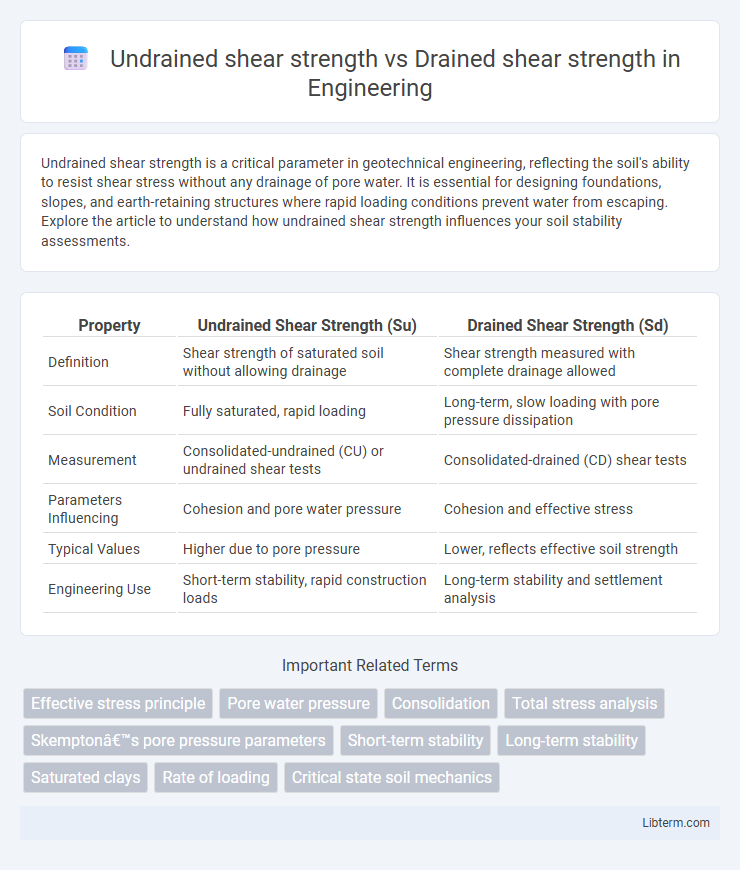Undrained shear strength is a critical parameter in geotechnical engineering, reflecting the soil's ability to resist shear stress without any drainage of pore water. It is essential for designing foundations, slopes, and earth-retaining structures where rapid loading conditions prevent water from escaping. Explore the article to understand how undrained shear strength influences your soil stability assessments.
Table of Comparison
| Property | Undrained Shear Strength (Su) | Drained Shear Strength (Sd) |
|---|---|---|
| Definition | Shear strength of saturated soil without allowing drainage | Shear strength measured with complete drainage allowed |
| Soil Condition | Fully saturated, rapid loading | Long-term, slow loading with pore pressure dissipation |
| Measurement | Consolidated-undrained (CU) or undrained shear tests | Consolidated-drained (CD) shear tests |
| Parameters Influencing | Cohesion and pore water pressure | Cohesion and effective stress |
| Typical Values | Higher due to pore pressure | Lower, reflects effective soil strength |
| Engineering Use | Short-term stability, rapid construction loads | Long-term stability and settlement analysis |
Introduction to Soil Shear Strength
Soil shear strength is a critical parameter in geotechnical engineering, defined by its resistance to shear stress without failure. Undrained shear strength measures the soil's strength when pore water pressure is not allowed to dissipate, typically relevant in short-term loading scenarios such as during rapid construction or seismic events. Drained shear strength, on the other hand, accounts for the soil's resistance after pore water pressures have equalized, reflecting long-term stability under slow loading conditions and is influenced by soil cohesion and internal friction angle.
Defining Undrained Shear Strength
Undrained shear strength refers to the maximum shear stress soil can resist without any drainage occurring during loading, commonly measured in saturated clays under rapid loading conditions. It is a critical parameter in geotechnical engineering, representing the soil's shear resistance when pore water pressure does not dissipate, often determined through laboratory tests like the unconsolidated undrained (UU) triaxial test. This strength contrasts with drained shear strength, which accounts for soil shear resistance after full drainage and pore pressure dissipation, crucial in long-term stability analyses.
Understanding Drained Shear Strength
Drained shear strength refers to the soil's resistance to shear deformation when pore water pressures have fully dissipated, allowing effective stress to govern the behavior. This parameter is critical in long-term stability analyses of slopes and foundations, where slow loading permits drainage and consolidation. Understanding drained shear strength involves measuring the soil's internal friction angle and cohesion under drained conditions, reflecting real-world scenarios in saturated soils with sufficient drainage.
Key Differences Between Undrained and Drained Shear Strength
Undrained shear strength refers to the soil's resistance to shear stress without allowing pore water to drain, primarily influenced by total stress and pore water pressure, making it crucial for short-term stability analysis in saturated cohesive soils. Drained shear strength measures the soil's resistance after complete pore water drainage, reflecting effective stress and soil particle friction, essential for long-term stability and slope design. The key differences lie in drainage conditions, the role of pore water pressure, and applicability to short-term versus long-term geotechnical assessments.
The Role of Pore Water Pressure
Undrained shear strength reflects soil resistance when pore water pressure builds up rapidly under short-term loading, preventing water drainage and causing effective stress to remain constant. Drained shear strength depends on effective stress changes as pore water pressure dissipates over time, allowing soil particles to rearrange and resist shear stress more effectively. The role of pore water pressure is crucial in distinguishing these strengths, as it controls the soil's effective stress and behavior during shear failure.
Laboratory Testing Methods for Shear Strength
Laboratory testing methods for shear strength primarily include triaxial and direct shear tests, differentiating between undrained and drained conditions based on pore water pressure dissipation. Undrained shear strength is typically measured using unconsolidated undrained (UU) triaxial tests, where rapid loading prevents drainage and reflects short-term soil behavior. Drained shear strength uses consolidated drained (CD) triaxial tests or direct shear tests with slow loading rates, allowing pore pressures to dissipate and providing long-term strength parameters essential for stability analysis.
Field Applications and Engineering Significance
Undrained shear strength is critical for evaluating short-term slope stability and foundation bearing capacity in saturated clays where pore water cannot dissipate quickly. Drained shear strength is essential for long-term stability analysis and design of earth structures under slow loading conditions, allowing pore pressures to stabilize. Field applications leverage undrained strength in rapid construction scenarios, while drained strength informs consolidation and settlement assessments crucial for sustainable engineering solutions.
Factors Affecting Undrained and Drained Shear Strength
Undrained shear strength primarily depends on soil consistency, clay content, and pore water pressure, with saturation levels significantly influencing cohesion in saturated clays. Drained shear strength is affected by effective stress, soil drainage conditions, and time-dependent consolidation, which govern frictional resistance and particle interlocking in granular soils. Temperature, soil fabric, and loading rate also play critical roles in modifying both undrained and drained shear strengths in various geotechnical conditions.
Practical Implications in Geotechnical Design
Undrained shear strength is critical for short-term stability analysis and rapid loading conditions, as it reflects soil behavior without allowing pore water pressure dissipation. Drained shear strength governs long-term stability and deformation under slow loading, relying on effective stress parameters with fully dissipated pore pressures. Accurate assessment of both strengths ensures reliable foundation design, slope stability evaluation, and earth retaining structure performance in variable drainage conditions.
Summary and Recommendations
Undrained shear strength represents soil resistance under rapid loading without drainage, crucial for evaluating short-term stability, whereas drained shear strength reflects long-term stability with full drainage and pore pressure dissipation. Soil type, drainage conditions, and loading rate significantly influence these parameters, demanding site-specific testing such as triaxial or vane shear tests for accurate assessment. Engineering designs should prioritize undrained shear strength for immediate load scenarios and incorporate drained shear strength in slope stability and foundation design for long-term performance.
Undrained shear strength Infographic

 libterm.com
libterm.com